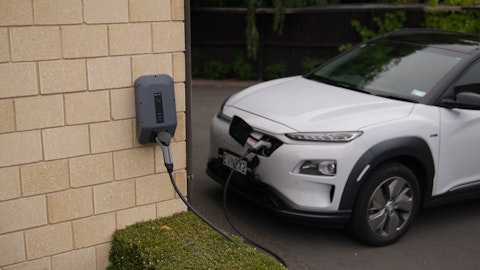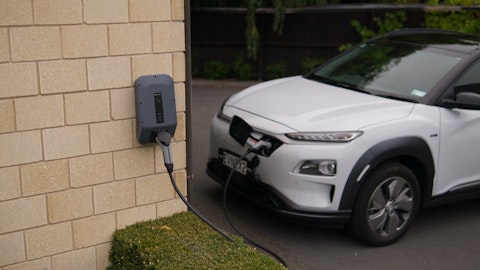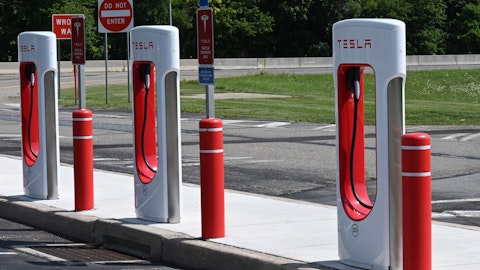And we continue to do that. The great thing about the post office deal is we’ve won other fleet deals, both commercial fleet deals, and we got another one in just the other day of a $2 million deal in, is that competitive advantage from manufacturing and from this cost-effective model that we can get in there and maintain high margins. DC Fast Charger, it’s a different story, right? You’re not going to get as highest margin, but if you can get the volume in, it’s very good for revenue. And then, you have to ship the manufacturing. And answer the question, yeah, there’s a lot more L2 deals out there, utility-driven and local-driven on a rebate format or in conjunction with the utility bill, even from multifamily dwellings and other. And we continue to align with those programs across the United States and Florida and in other jurisdictions that offer them.
And it’s just — I mean Craig, I can’t say more about the maintenance and the upkeep difference between a heavy DC fleet and a heavy L2 fleet. It’s just remarkably different in terms of the upkeep, the maintenance. And as we’ve discussed many, many times, if I’m looking at an owner-operated model and install of an L2 that is full turnkey by Blink, I just need 18 months for a payback on 10% utilization. And if it’s a hybrid, I need a year at 10% utilization. That really sets us apart because you know by the numbers you’ve done, DC fast charging doesn’t have the same profile.
Craig Irwin: Understood. That makes a whole lot of sense. So, the second question I want to ask is about your revenue guidance. $128 million to $133 million is a nice increase, obviously, following through on the strengths in the third quarter. That implies that the consensus numbers are bracketed by what you’re giving us as guidance tonight. Can you maybe talk a little bit about the sequential progression here? Is there maybe some conservatism in the way that you’re looking at the fourth quarter? Or is there potentially some supply chain considerations? Or maybe — are you anticipating just a small impact of the move to the new facility in Bowie, Maryland, having a short-term impact on your throughputs? Can you maybe just describe the sequential?
Brendan Jones: Sure. Yeah, so let’s start with the last one. So we don’t anticipate. We’re going to do parallel processing out of Bowie. So, as the new facility comes online, we’ll still be processing out of the Tesla Drive location, and then the new location will begin operations. So, you might have a 24-hour cycle with this interruption, but it won’t be anything more than 24 hour, maybe 36 hour at the outset. Otherwise the team has got a good plan together to ramp up and change very, very quickly. Now, when we look at what happened and yeah there was a little bit of — we got the opportunity to ship and we had a lot more product come in in the month that was already booked. And the warehouse situation, as, Craig, I’ve discussed with you in the past, isn’t great, right?
So, we want to maintain a throughput push. So, instead of holding and saying, “Hey, we’ll count that next quarter,” we pushed everything through because we had a whole bunch of bookings that were coming in in terms of product into the warehouse for Q4. And frankly, we couldn’t hold both, right? So, that increased revenue. We had some of those bookings were going to be in Q4, but they ended up in Q3, which really gave us a good number. So, there’s a smoothing effect going in to Q3, where it’s not going to be as high as the number as we saw this month, but it’s still going to be one of the best we’ve ever had.
Craig Irwin: Excellent. And then, last question if I may, your charging service revenue is just doing fantastic. So, you’re obviously seeing the same benefit that EVGo is. People are driving their EVs more and using third-party charging more. But can you maybe talk about your mix of endpoints and your expectations for utilization on the network? I know there’s some legacy endpoints versus endpoints that you’ve invested in more recently. How do you feel about the potential for continued increases in utilization and throughputs on the network?
Brendan Jones: Yeah. We feel very good about the choices we’ve been making over the last three-plus years. As you indicated, we had some legacy chargers out there that weren’t doing as well, but we analyzed the book of business on — and let’s go to the owner-operator model, both in Europe and in the U.S. We’re seeing greater than 15% utilization on average in the majority of chargers that we installed using our new methodology and there’s no wacky science to the new methodology. It’s basically a platform of ArcGIS appended with a lot of data. It looks at how many chargers are coming into the space, including competitors, looks at how many EVs are going to be sold, looks at the geographic implications of where the site has, and makes sure that that site meets our projected utilization.
And we’ve been using that in Europe and the U.S. in a disciplined manner, since about November of 2020. And those sites and those new installations that have happened do much better. Now, we’re also working with the older sites and where we can upgrade, move, or change chargers, we’re doing so. We’re doing some upgrades now on locations where we believe that with new equipment that is higher than the existing infrastructure, which is mostly 50 kilowatt, we’re going to get a higher degree of utilization on that. The operations team led by the COO Mike Battaglia has that underway. So, that’ll give us some benefit, but it’s going to be marginal. So, it’s really sticking to our guns on the owner-operator model, whether hybrid or other, on making sure we have a disciplined approach to both investments and to charger placement.



